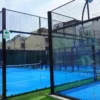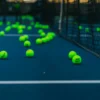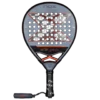Check out our latest additions to the websites - if you're looking for rackets, balls, bags or clothing - Gear up for victory!
Shop NowConfused about whether to step into the padel or squash court? Although both sports look similar, they stand at two different poles. The gameplay, equipment, and strategies are different. So, in case you are curious to dig into this topic and learn more about the difference between Padel and Squash, this piece is for you. Here we will end the Squash vs Padel debate, revealing the key difference and finding which game is the best for which type of player.
Table of Contents
Padel vs Squash Rules
Although in the end, it comes down to hitting the ball perfectly no matter whether you play squash or padel, like every game, there are some rules surrounding these two. These rules impact your gameplay, strategies, and speed; that’s why knowing them is super important.
Check out the most standard Padel and Squash rules below –
Scoring System
The scoring system of padel almost replicates the tennis setup. Padel matches are usually played in best-of-three sets, with the first person or team to reach six games—as long as they lead by at least two games—winning each set. In case the score reaches 6-6, a tiebreaker is used to determine the set. In padel, you can take longer rallies similar to tennis as you get more time to set your strategies and play more tactically.
Squash follows the PAR points system. Now, what is this PAR? PAR is Point-a-Rally. In this format, each rally rewards you a point, no matter who served. While the games are played to 11 points, you must win by at least 2 points if the score is equal to 10. The first player to win the set number of games wins the squash matches, which are often played in a best-of-three or best-of-five style. This point system ensures to keep you on your toes, as at any moment the match can twist.
Gaming Environment
The way the court is set up and how it affects gameplay defines a major aspect of the Padel vs Squash battle. In padel, the court is surrounded by walls. So, you are allowed to use the walls to rebound shots. if you use this strategically, you play with the ball’s trajectory. This rule allows you to take longer rallies as the ball has more chances to stay in play.
The main purpose of the walls in squash, on the other hand, is to keep the ball inside the smaller court. Despite having three closed sides, squash courts have a smaller play area and allow the ball to bounce off any wall, which speeds up play. That’s why squash requires quick reactions, agility, and quick bounces, all thanks to the constrained environment.
Padel vs Squash Courts
You can spot the differences between squash and padel courts just by looking at them. The size and layout of the courts of the two sports are pretty different. A squash court stands around 9.75 meters in length and 6.4 meters in width. The squash court comes with four walls, with the front wall being the main target for strikes. This is the setup of a single squash court. Due to its smaller size, the games are super intense, and your hands and feet are always busy. However, doubles squash courts are a bit larger. They measure around 13.72 meters in length and 7.62 meters in width.
When it comes to padel, the court size is usually larger, with a dimension of 20m x 10m. The padel courts come with enclosed glass walls on the sides and back. This wall setup allows the ball to bounce back from the wall. On top of that, padel is played across the net, differing from squash, which is played towards the wall.
Padel vs squash equipment
You can’t play cricket with a volleyball bat. Similarly, Padel and Squash come with their own set of equipment. The choice of gears plays a big role in the Padel vs Squash battle, defining your play style and experience. So, how are these two sports different in terms of equipment?
Racket Design:
If you are a beginner, you won’t find a difference between a squash racket and a tennis racket. Both closely resemble each other. They are typically longer, lightweight, and have a narrow frame and strings. Usually, they weigh around 140 to 180 grams. Thanks to these long handles and their unique design, these rackets allow you to generate more power for precise and quick shots. This type of design enables squash players to survive those intense sessions with fast reflexes.
On the other hand, things are a bit different with padel rackets. They are smaller in size, solid, and made from composite materials like carbon fiber or such materials. Typically they come with holes that make them lighter and more maneuverable. However, they are generally heavier than squash rackets, weighing around 350 to 375 grams. The padel rackets come in different shapes like teardrop, round, diamond, and more. Each one has different traits in terms of control, power, and mobility.
Ball Specifications:
Like the rackets, balls are also a bit different when it comes to the two games. Squash balls are usually smaller than padel balls, coming with a diameter of around 40mm. That’s not all. They offer low bounce and are generally made of a rubber compound that compresses with each hit. Thanks to this build, the balls move lightning fast, and they bear intense rallies during long squash sessions.
On the other side of the coin, the padel balls are slightly bigger in size, and they are known for their bounce. They produce higher bounce than the squash balls, enabling long and slow-paced sessions.
Is squash more difficult than padel?
A trending question that most beginners in the sports world ask is, Squash vs Padel: which is the more difficult game? And that’s fair to ask as a newbie, as a game with a low entry barrier is easy to grasp. While everything depends on how hard you try or what your interest is, according to experts, squash has a stiff learning curve. That’s because the game takes place on a smaller court, demanding rapid moves. You can’t take it slow. Squash requires quick reflexes, more powerful shots, better strategic thinking, and more control.
On the other hand, when it comes to padel, the entry barrier is pretty low. The game is very similar to tennis. The court is slightly bigger, and the intensity of the game depends on the situation and your play style. You can take it slow or aggressively. As a beginner, you can start with more controlled and slow moves. To answer the question of Padel vs Squash, which is more difficult, if you listen to the pro athletes, they will say Squash. But to be frank, no new game is free of challenges. Every game comes with a set of unique challenges, and in the end, it turns out how you use your skills, your interests, and how dedicated you are towards the game.
Does Padel burn more calories than squash?
The bond between sports and cardio is unbreakable. That’s why both padel and squash are excellent for cardio. But many players often get stuck in the Padel vs Squash battle, asking which one burns more calories. So, let’s end the debate.
Long story short, playing padel burns more calories than squash, and that’s a fact. But let’s understand why. One of Padel’s gameplay can burn 600–1000 calories depending upon your game style and intensity of the game. The game demands constant movement and quick reflexes, and that’s why you will burn significant calories. If you want a sport that gives you a full-body workout that works your leg and core muscles, as well as your arms, shoulders, and brain, Padel is one of the best.
On the other hand, squash is also a high-intensity game that helps you burn a good amount of calories. However, squash matches are generally short, lasting about 40 minutes, but during the game, you are in constant motion. That’s why you burn anything between 500 and 800 calories in a single session. Overall, the amount of exact calories you burn solely depends on your game style and the situation of the games. In some situations, the game may take you a bit slow, while in some you will have to put in that extra effort, thereby burning more calories.
See more guides:





